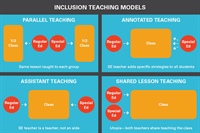When the phone rings in the middle of summer and you see your principal’s number coming across the screen, you can’t help but wonder, “What did I do?”
A few years ago, when I answered such a call, my stomach dropped as my administrator cheerfully told me about a wonderful “opportunity” that awaited me during the coming school year. I was being assigned the eighth grade math inclusion classes and would work with a special education teacher for four class periods each day. I would have general education students as well as students who have IEPs or 504 modifications.
My first reaction (like that of any good teacher) was “Of course, I would be happy to do this!” After I put the phone down, reality set in. I was going to have to share my space, my students, my entire world with a stranger. The feelings of being the kid in group projects who did all the work while my teammates goofed off quickly resurfaced. I had heard horror stories about how co-teachers never did any teaching or how they didn’t help with management or grading.
However, I’m a problem solver and an overachiever by nature. If I were going to get this “opportunity,” I wanted to do my best for my students and my school. I immediately began searching online for conferences, webinars, and books about co-teaching. I read, watched, and attended anything I could find that dealt with co-teaching or special education students.
Tips for Co-Teaching

Some common themes became evident throughout my summer research and by the time I met my co-teacher, I felt prepared to contribute to an environment that was built on partnership, trust, and mutual responsibility. These tips are gleaned from my efforts to prepare.
Start early. From the minute you know who your teaching partner is, get to know him or her as a person. Talk about family, pets, hobbies, work experience, childhood. You may not end up being best friends, but you can build a good working environment and establish mutual respect as individuals and as colleagues.
Discuss teaching styles and content background. Thankfully, my co-teachers have had strong math backgrounds, which allowed each of us to teach in our own ways. Other co-taught classes may not be as flexible; the strong content teacher may need to take the lead with the partner providing support.
Examine your teaching habits. Assessing and understanding your strengths and weaknesses will allow you to work with your partner as a support system in weaker areas and vice versa. In our classroom, we always knew each other’s weak side and quickly learned to compensate when necessary.
Take an honest look at your classroom management practices. You can’t expect to work successfully with someone else until you know your own deal breakers or trigger issues. Some of the first conversations I had with my co-teachers included questions like “Does it bother you for students to leave the class without pushing in their chairs?” and “What if a student gets up and sharpens his pencil during a lesson?” and “What color ink do you use to grade papers?” This may not seem like a big deal at the beginning when everything is still in the newlywed stage, but five or six months into a school year, issues like these can cause hurt feelings, tension, or a big blow-up that could have been avoided.
Respect each other. Mutual respect is a must in a successful co-teaching classroom. This person is not trying to “take your job,” but is working with you.
Co-Teaching Styles
There are many types of co-teaching or team-teaching models in schools, but one of the most common is similar to mine: a general educator is paired with a teacher who specializes in special needs students. Even if the co-teaching pair is structured in a different way, there are similarities in the types of teaching that most often occur in a co-taught classroom.
One Teach–One Observe. This model allows the members of a new co-teaching team to get to know each other or it can fully utilize one teacher’s strengths in an area. One teacher teaches and the other, the observer, monitors students for comprehension and behaviors, or makes anecdotal notes for future use. Just a note: This does not mean the general educator is always teaching and the second teacher is always observing. Try reversing the roles occasionally to provide a new point of view for the students and the teachers.
One Teach–One Drift. This model is great for new teams as well. One teacher is the main instructor while the other drifts around the room, interacting with students or groups. This type of interaction allows for more one-on-one time and additional opportunities for students to ask questions of a teacher without having to stop the flow of a class or the lesson. Planning time is minimal.
Parallel Teaching. In this type of teaching, students are split into two groups, each led by one of the co-teaching pair. This strategy allows for review or for special attention to a smaller group of students who are learning a difficult subject. This method requires more planning because both educators have a common teaching goal.
Station Teaching. The use of stations in the classroom is not a new concept, but within a co-teaching classroom these stations can be tailored to the needs of the students. Two educators supervising and interacting with students at different stations can promote student understanding. In our math classes, these stations were often used for hands-on geometry activities with little “teaching” necessary. Station teaching requires quite a bit of pre-planning to be effective.
Alternative Teaching. This is similar to parallel teaching with regard to the amount of planning needed and the fact that students are separated. In this scenario, one of the co-teachers works in an alternate location with students who need a more intensive intervention or review of material before moving forward in the subject. This model is effective for re-teaching or for test review.
Team Teaching. Team teaching is an ideal situation in which both teachers are comfortable with the content, the students, and each other. Within a team-taught classroom, the teachers move seamlessly into roles throughout the lesson with neither dominating the other. Lessons are more conversational between the teachers and students and the environment is engaging. Teachers are able to fill whatever role or need is required at the time: Does a prompt need to be given? Does another student need a quick one-on-one review? Would another point of view help clarify a concept? In a successful team-taught class, an onlooker sees two teachers interacting with a group of students as a cohesive unit.
My teaching partner and I worked together many years before she moved on to a different school and I repeated the process with another special education teacher. As a math general educator, I can testify that my years co-teaching have been some of the most fulfilling, challenging, and worthwhile of my teaching career.
Samantha Dooley is the math general educator partner of a co-teaching team at a 6–8 middle school in Arkansas. s.dooley74@gmail.com
Published in AMLE Magazine, November 2014.
